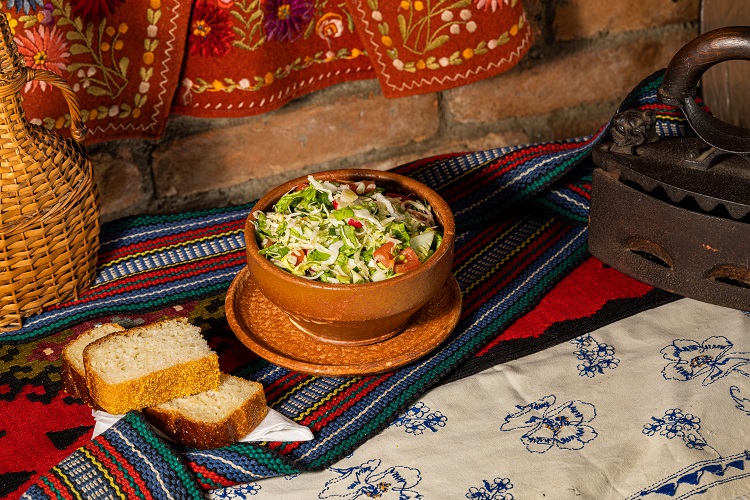Many different types of meat are produced here, and milk is one of the jewels in the country’s crown. There’s also a real focus on organic agriculture, with respect for the environment one of the main drivers in food production.
If you’re curious to taste one of Serbia’s most famous specialties, you might like to start with Pule, a rare and exclusive cheese produced from delicious donkey milk. These animals are reared in the Zasavica region, about 80km from Belgrade, where they are milked by hand and raised with the utmost care. It takes about 25 litres of donkey milk to produce just one kilogram of this cheese, which has an intense and unmistakable flavor, including a slight hint of smokiness on the palate. Pule is so exclusive that it is only made to order, and then exported around the world. It is said that although this may be the most expensive cheese in the world, it is worth every cent!
Another specialty that you won’t want to miss is Vacca Buša beef. The importance of this breed is recognised by its inclusion in the Slow Food Ark of Taste, an organisation that aims to protect the planet’s biodiversity both on land and at sea, with a particular focus on species that are in danger of extinction. Originally from the Balkans, Buša are a primitive breed of cattle which are smaller than normal breeds and have coats of different colors (grey, yellow, red, brown, striped, black or white). Their meat is lean and full of flavour, thanks to the many herbs that grow in the pastures where they graze, while their milk is appreciated for its flavour and high fat content: about 1 000 litres of milk are produced annually. This breed was at risk of extinction, but in the year 2000 the introduction of state subsidies and the efforts of breeders have succeeded in pulling it back from the brink.
From its ingredients to its cuisine, Serbia never disappoints, and each region has its own gastronomic specialty. In Vojvodina they make excellent home-made pasta, bread and strudels, as well as various beef- and poultry-based dishes.
In Šumadija, pite zeljanice (savoury pie with spinach) and spit-roasted pork are typical specialities. Smoked meat dishes are a favorite in western Serbia, while sheep are the main livestock farmed in the Zlatibor and Zlatar mountains. The cuisine of eastern Serbia features čobanske pite (savoury pies with meat and vegetables), lamb cooked in milk, smoked wild boar, janjija (a dish prepared using three types of meat and mixed vegetables), and homoljski kačamak (a delicious maize polenta). In southern Serbia, meat is often grilled or spit-roasted – authentic cooking methods that bring out its full flavor.


In Serbia, meals usually begin with a copious selection of cold starters that includes proja (bread made from maize flour), sir (cheese) and kajmak (cream), as well as a vast array of cured meats such as ham, pork sausage, Serbian salami and smoked coppa. Buffets will also feature hard-boiled eggs, chilli peppers, spring onions and, in winter, pihtija, a jellied meat made from cheaper animal cuts, and prebranac, a spicy bean stew.
Also popular in winter are vegetable sarmica – vine leaves or cabbage leaves filled with rice, onion, paprika, tomato and parsley. And if you like fish, make sure you try the local zander, the king of the Danube, which is particularly popular in the Golubac region of central Serbia.
Warm starters include gibanica and zeljanica, two types of savoury pies filled with cheese, cream and eggs, spinach and cabbage, as well as breaded peppers, courgettes and aubergines served with a tartare sauce.
The meal continues with soups made with meat (veal, chicken, lamb or beef) and vegetables, which are often sour and spicy. And if you like meat, you’ll be in your element in Serbia. Barbecues are used to grill ćevapčići (a type of patty made from minced veal, which is laid on ice and shaped into small sausage-like rolls, then served with fresh, finely chopped onion), hamburgers, sausages, chops, kebabs, steak fillet and much more besides, all of which are accompanied by home-made focaccia. Karadjordje steak (named after the military leader who led the first revolt against the Turks) is a particular highlight: this veal steak is rolled with cream and ham, covered with an egg and breadcrumb mixture and then fried in copious amounts of lard, before being served with tartare sauce and a glass of good red wine.
Šumadija veal cutlets, made with top-quality veal and served with Serbian cheese, tomato, pancetta ham, sour cream, potatoes, rice and chili pepper are also excellent. A favorite dish in spring, lamb kapama is prepared by frying pieces of lamb with spring onions and leeks, adding baby spinach and then cooking slowly in a casserole. Another delicious dish is Serbian djuveč made with tomatoes, peppers, potatoes, rice, chili pepper, and slices of pork which have been fried with onion, all of which is then baked in the oven.
Winter specialties include podvarak – sour cabbage slow cooked with onion, lard and pancetta ham and served with roast pork or turkey. Lamb is also very popular in Serbia and is used to make sarmica – cabbage leaves stuffed with black and white lamb’s liver, rice, egg, braised onion and spices, which are then covered with milk and beaten eggs and baked in the oven.
Zander makes a frequent appearance on menus, both as a starter and a main dish. This fish is often served “Smederevo”-style, where the fillets are cooked with onion, tomato, peppers, parsley and white wine, and seasoned with salt, pepper and lemon. Even more delicious are zander fillets stuffed with ham, onion, rice and grated potato. And if you don’t like bony fish, you might like to try catfish: pieces of this fish are fried in oil and served with boiled potatoes and lemon.


Main courses in Serbia are nearly always accompanied by delicious mixed salads made with tomatoes, peppers, onions and chili peppers, with grated Serbian cheese and grilled vegetables often added to make a more elaborate salad.
Any self-respecting Serbian lunch or dinner finishes with pita, a dry cake made from a special dough that is rolled out in layers, topped with chopped walnuts and baked in the oven. Other dessert options include orasnice (horseshoe-shaped delicacies made with walnuts, sugar and eggs). Serbia also boasts excellent apple or sour cherry strudel, often decorated with poppy seeds. And don’t miss the palačinke – pancakes stuffed with walnuts, jam or chocolate and either baked in the oven or served flambéed with cherry liqueur or cognac.
A vast selection of top-quality white, red and sweet wines is available to accompany these local dishes and specialities, all of which bring out the different characteristics of Serbia to the full.
To satisfy your curiosity further, all you have to do is plan a trip to Serbia, or perhaps order some of these excellent Serbian ingredients from one of the many specialist websites available online – the perfect introduction to a fascinating country and its delicious and varied cuisine!













